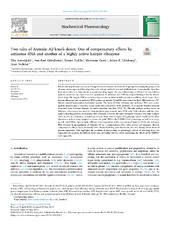| dc.contributor.author | Aareskjold, Elin | en_US |
| dc.contributor.author | Grindheim, Ann Kari | en_US |
| dc.contributor.author | Hollås, Hanne | en_US |
| dc.contributor.author | Goris, Marianne | en_US |
| dc.contributor.author | Lillehaug, Johan R. | en_US |
| dc.contributor.author | Vedeler, Anni | en_US |
| dc.date.accessioned | 2020-04-15T08:44:49Z | |
| dc.date.available | 2020-04-15T08:44:49Z | |
| dc.date.issued | 2019-05-31 | |
| dc.Published | Aareskjold E, Grindheim AK, Hollås H, Goris M, Lillehaug JR, Vedeler A. Two tales of Annexin A2 knock-down: One of compensatory effects by antisense RNA and another of a highly active hairpin ribozyme. Biochemical Pharmacology. 2019;166:253-263 | eng |
| dc.identifier.issn | 0006-2952 | |
| dc.identifier.issn | 1356-1839 | |
| dc.identifier.uri | https://hdl.handle.net/1956/21860 | |
| dc.description.abstract | Besides altering its own expression during cell transformation, Annexin A2 is upregulated during the progression of many cancer types and also plays key roles during viral infection and multiplication. Consequently, there has been great interest in Annexin A2 as a potential drug target. The successful design of efficient in vivo delivery systems constitutes an obstacle in full exploitation of antisense and RNA-cleaving technologies for the knock-down of specific targets. Efficiency is dependent on the method of delivery and accessibility of the target. Here, hairpin ribozymes and an antisense RNA against rat annexin A2 mRNA were tested for their efficiencies in a T7-driven coupled transcription/translation system. The most efficient ribozyme and antisense RNA were subsequently inserted into a retroviral vector under the control of a tRNA promoter, in a cassette inserted between retroviral Long Terminal Repeats for stable insertion into host DNA. The Phoenix package system based on defective retroviruses was used for virus-mediated gene transfer into PC12 cells. Cells infected with the ribozyme-containing particles died shortly after infection. However, the same ribozyme showed a very high catalytic effect in vitro in cell lysates, explained by its loose hinge helix 2 region. This principle can be transferred to other ribozymes, such as those designed to cleave the guide RNA in the CRISPR/Cas9 technology, as well as to target specific viral RNAs. Interestingly, efficient down-regulation of the expression of Annexin A2 by the antisense RNA resulted in up-regulation of Annexin A7 as a compensatory effect after several cell passages. Indeed, compensatory effects have previously been observed during gene knock-out, but not during knock-down of protein expression. This highlights the problems in interpreting the phenotypic effects of knocking down the expression of a protein. In addition, these data are highly relevant when considering the effects of the CRISPR/Cas9 approach. | en_US |
| dc.language.iso | eng | eng |
| dc.publisher | Elsevier Inc | eng |
| dc.rights | Attribution CC BY-NC-ND | eng |
| dc.rights.uri | https://creativecommons.org/licenses/by-nc-nd/4.0/ | eng |
| dc.subject | Annexin A2 | eng |
| dc.subject | Ribozyme | eng |
| dc.subject | Antisense RNA | eng |
| dc.subject | Off-target | eng |
| dc.subject | Compensatory effect | eng |
| dc.title | Two tales of Annexin A2 knock-down: One of compensatory effects by antisense RNA and another of a highly active hairpin ribozyme | en_US |
| dc.type | Peer reviewed | |
| dc.type | Journal article | |
| dc.date.updated | 2019-11-15T14:32:44Z | |
| dc.description.version | publishedVersion | en_US |
| dc.rights.holder | Copyright 2019 The Author(s) | |
| dc.identifier.doi | https://doi.org/10.1016/j.bcp.2019.05.028 | |
| dc.identifier.cristin | 1721125 | |
| dc.source.journal | Biochemical Pharmacology | |

